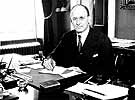
|
|
|

|

|

|

|
|
Click on an image to see a larger, more detailed picture.
|
|
|
|
|
| 1944: Desperate Acts |

|
pg. 508 |

|
|
|
|
| |
 Many camps and ghettos kept detailed records of the number of deaths that occurred at those sites. This chart, from January 1, 1944, shows the number of deaths in Theresienstadt--the "model" ghetto and concentration camp in Czechoslovakia--between November 24, 1941 (when construction of the camp began), through the end of 1943. About 33,000 people died in Theresienstadt. In addition, almost 88,000 of the camp's inmates were deported to their deaths in the gas chambers of Auschwitz.
Many camps and ghettos kept detailed records of the number of deaths that occurred at those sites. This chart, from January 1, 1944, shows the number of deaths in Theresienstadt--the "model" ghetto and concentration camp in Czechoslovakia--between November 24, 1941 (when construction of the camp began), through the end of 1943. About 33,000 people died in Theresienstadt. In addition, almost 88,000 of the camp's inmates were deported to their deaths in the gas chambers of Auschwitz.
Photo: Czechoslovak News Agency/United States Holocaust Memorial Museum Photo Archive
|
 A close friend of President Franklin Roosevelt, Henry Morgenthau, Jr., was secretary of the Department of Treasury and the highest-ranking Jewish member of the administration. In early 1944 Morgenthau received a document from several of his subordinates entitled "Report to the Secretary on the Acquiescence of This Government in the Murder of the Jews." Taking the report to the President, Morgenthau set the wheels in motion to establish the War Refugee Board, responsible for saving some 200,000 lives in the closing months of the war.
A close friend of President Franklin Roosevelt, Henry Morgenthau, Jr., was secretary of the Department of Treasury and the highest-ranking Jewish member of the administration. In early 1944 Morgenthau received a document from several of his subordinates entitled "Report to the Secretary on the Acquiescence of This Government in the Murder of the Jews." Taking the report to the President, Morgenthau set the wheels in motion to establish the War Refugee Board, responsible for saving some 200,000 lives in the closing months of the war.
Photo: National Archives/United States Holocaust Memorial Museum Photo Archive
|
 The Jewish Sara Lamhaut (left), under the assumed name of Jeannine van Meerhaegen, prepares for her Catholic First Communion. Sara's parents, Icek Leib and Chana Laja Goldwasser, fought with the Belgian partisans until they were denounced, arrested, and eventually sent to their deaths at Auschwitz. Hidden in various convents, including that of Soeurs de Sainte Marie, near Brussels, Sara survived the war to be reunited with friends of her parents, who became her guardians. Working together, the Jewish underground and the Belgian Catholic Church succeeded in hiding some 4000 Belgian-Jewish children.
The Jewish Sara Lamhaut (left), under the assumed name of Jeannine van Meerhaegen, prepares for her Catholic First Communion. Sara's parents, Icek Leib and Chana Laja Goldwasser, fought with the Belgian partisans until they were denounced, arrested, and eventually sent to their deaths at Auschwitz. Hidden in various convents, including that of Soeurs de Sainte Marie, near Brussels, Sara survived the war to be reunited with friends of her parents, who became her guardians. Working together, the Jewish underground and the Belgian Catholic Church succeeded in hiding some 4000 Belgian-Jewish children.
Photo: Sara Lamhaut Boucart/United States Holocaust Memorial Museum Photo Archive
|
|

|

|

|

|
 1944: The Nazi extermination industry is at its peak and is staffed by 47,000 well-trained, full-time people.
1944: The Nazi extermination industry is at its peak and is staffed by 47,000 well-trained, full-time people.
|
 1944: Worker life expectancy at I.G. Farben's Bunawerk (Buna works) synthetic-rubber and oil plant at Auschwitz, Poland, is three to four months. In coal mines: one month.
1944: Worker life expectancy at I.G. Farben's Bunawerk (Buna works) synthetic-rubber and oil plant at Auschwitz, Poland, is three to four months. In coal mines: one month.
|
 1944: King Gustav of Sweden and Pope Pius XII pressure Hungary to halt deportations of Jews.
1944: King Gustav of Sweden and Pope Pius XII pressure Hungary to halt deportations of Jews.
|
 1944: Axis Rule in Occupied Europe, a book by jurist Raphael Lemkin, describes Nazi rule and the murder of Jews as a return to barbarism. Lemkin coins the word "genocide," from the Greek genos (nation/people) and cide (to kill).
1944: Axis Rule in Occupied Europe, a book by jurist Raphael Lemkin, describes Nazi rule and the murder of Jews as a return to barbarism. Lemkin coins the word "genocide," from the Greek genos (nation/people) and cide (to kill).
|
 Early 1944: The Nazi Propaganda Ministry releases a film, The Führer Gives the Jews a Town, a largely fabricated look at the alleged good life enjoyed by Jews in the camp/ghetto at Theresienstadt, Czechoslovakia.
Early 1944: The Nazi Propaganda Ministry releases a film, The Führer Gives the Jews a Town, a largely fabricated look at the alleged good life enjoyed by Jews in the camp/ghetto at Theresienstadt, Czechoslovakia.
|
|
|
|
|
| 1944: Desperate Acts |

|
pg. 508 |

|
|
The Holocaust Chronicle
© 2009 Publications International, Ltd.
|
|
